Nylon filament and textile industry under severe pandemic situation
March 2022 witnesses the most extensive impacts from the COVID-19 pandemic on China, ever since its outbreak at the end of 2019. March is also the traditional peak season of textile industry, its influence on textiles and chemical fiber industries have reached a great intensity. Even when upstream chemical raw material prices rise significant, middle and downstream sectors react weakly or even have no reaction. The further the downstream link is, the weaker the demand.
For nylon 6 industrial chain (CPL-nylon 6 chip-nylon 6 filament), nylon 6 filament market is weakest part, and CPL and nylon 6 chip market are more closely related to upstream petrochemical market.
As the pandemic is spreading in many parts of the country, the prevention policies and lockdown in different regions restrict the flow of logistics and personnel, causes rising time and cost of delivery, cut down new orders and damage downstream players’ confidence. Even though the influence cannot but quantified by now, there are some indicators to take a look at nylon filament, fabric and textiles and apparel industries.
COVID infections VS NFY capacity distribution in China
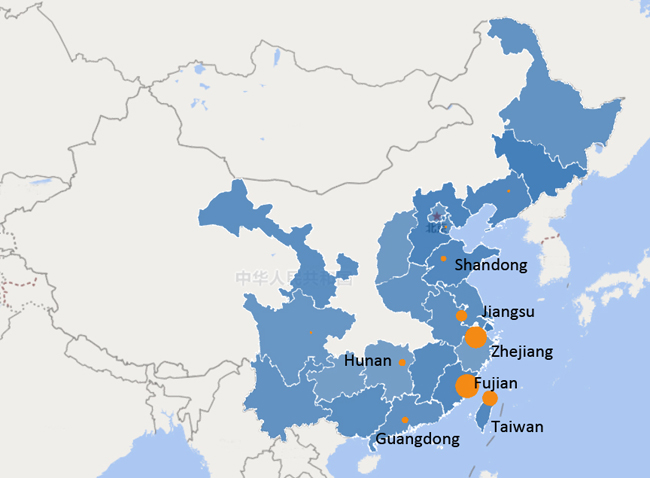
*The blue part is COVID-19 infections in Chinese mainland and Taiwan province on March 24, according to the latest data released by National Health Commission by midnight, March 24, 2022.
The orange part refers to nylon 6 filament capacity.
On March 24 alone, Chinese reported 4,988 new infections, 3,622 of which are asymptomatic, according to the municipal health commission. And in the most nylon 6 filament capacity-concentrated provinces, Fujian, Zhejiang, Jiangsu, Shandong and Guangdong, all have reported newly infections daily. In addition, with a prominent of NFY production capacity, Taiwan province is also influenced with rising cases.
But NFY production is not evidently influenced, since NFY plants basically run stably around 81-82% in March 2022. But since its downstream mills have lower operating rate compared with the same period of previous years, the supply-demand burden is especially built up in NFY link.
Pandemic situation is severe in China
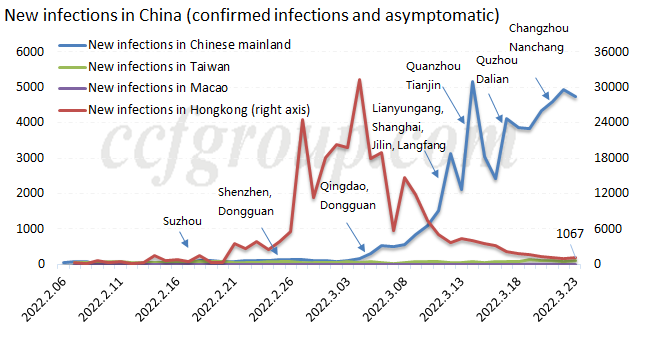
After the Spring Festival (mid-February), the pandemic situations in Suzhou, Shenzhen, and Dongguan have repeated, but the impact is still relatively limited. The current round of pandemics in mainland Chinese mainly started in early March, since the resurgence in Dongguan (Guangdong province) and the surge in cases in Qingdao (Shandong province), the number of new infections has risen rapidly. Around mid-March, multiple cases occurred in Shanghai, Jilin province, Lianyungang, Langfang (both Shandong province) and other places. Most of the above listed cities are related to the textile industry.
In addition, some other textile bases including Huzhou, Haining (Zhejiang province) and Wuxi (Jiangsu province), though have not many infections, have taken a serious prevention and thus affected local production, sales and consumption for textiles.
As of March 23, there are a total of 635 medium and high risk areas across the country, involving 49 cities in 21 provinces. And recently, the National Health and Medical Commission stated that the number of newly infected people in the country is still increasing rapidly, and the situation of pandemic prevention and control is still severe and complicated. In the past three years, infections were scattered and the influence usually lasted for 15-25 days and could be basically controllable, but the inflection point of this round is still unclear.
Part of textile and apparel markets have stopped
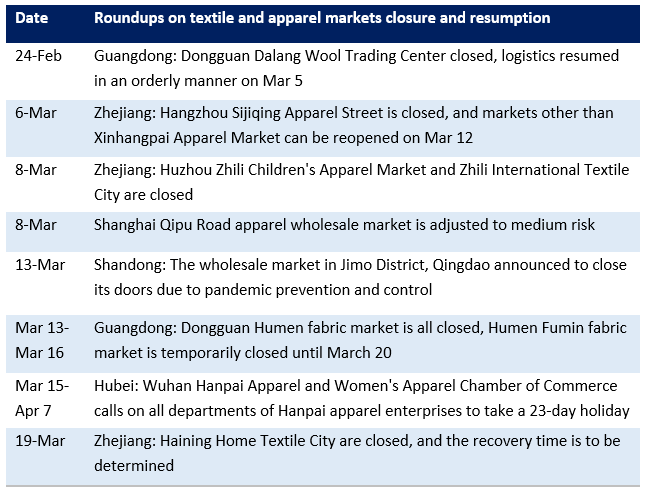
Textile and apparel markets in many cities have also been closed due to the pandemic. Different pandemic prevention policies in different regions restrict the flow of logistics and personnel, so that even though a small number of markets that were closed early have gradually reopened, new orders and shipments have not resumed as before. It is still uncertain when the closed market will be unsealed, and it is unknown whether the backlogged spring products inventory still have the opportunity to be sold.
Influence on the logistics
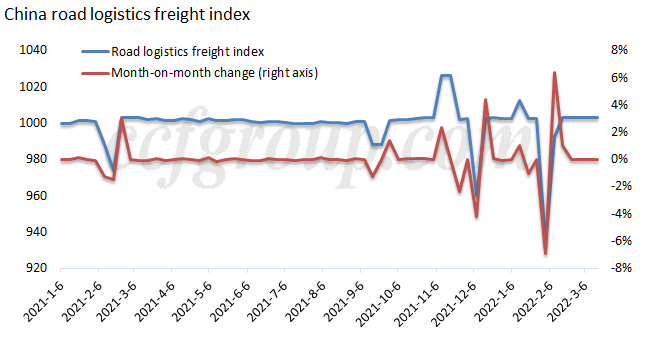
The control of logistics in various regions has also been tightened to varying degrees. In areas with relatively severe pandemics or strict control, the time taken for trucks to enter and leave has increased significantly. In addition, the cost of refined oil has continued to rise recently, and the freight rate has also increased. For some enterprises, it not only affects the delivery time, but also increases the cost.
Judging from the general index of China's road logistics freight rate, it has been stable in the near future, and the actual impact is mainly in the areas where the pandemic is strictly controlled.
Influences on consumption for apparels
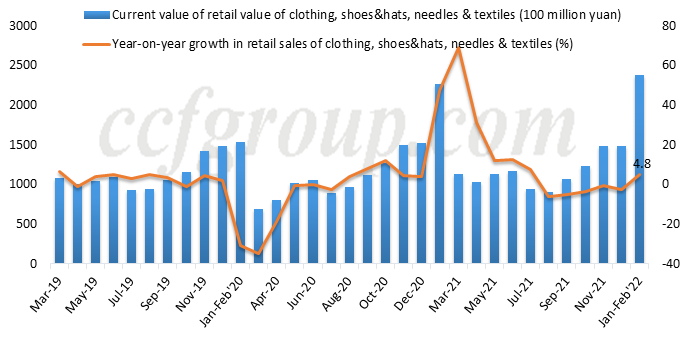
By March 23, there are already 49 cities ranked medium and high risks, and still more cities have recently been classified into this risky group. The offline consumption of apparel in these cities is inevitably reduced, and due to the control of some express companies, the express delivery business to the risk areas are stopped, thus demand for online sales is cutting down as well.
In addition, due to the delayed update on the pandemic data of various regions, some cities that have been listed as medium or high risks are also being rejected. For example, Hangzhou of Zhejiang province has maintained a low risk for more than a month, but still many regions reject express delivery to Hangzhou.
The January-February textile and apparel retail sales data released by the Bureau of Statistics showed steady growth, but the impact of the pandemic on online and offline apparel consumption in March will be verified after the release in April.
Fabric mills' operating rate is lower than the same period of previous years
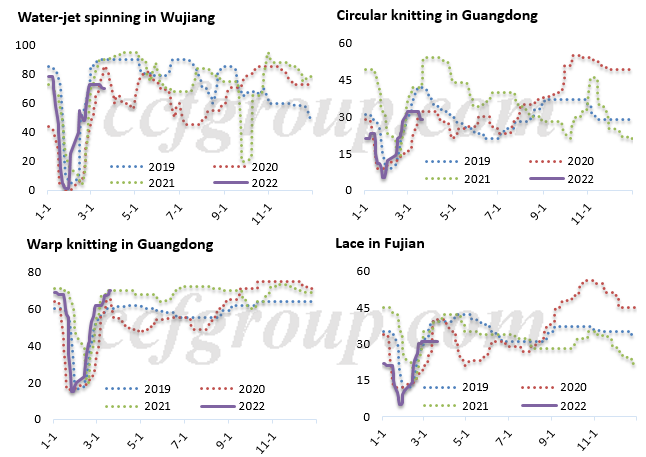
The pandemic also has varying degrees of impact on textile production.
Water-jet spinning in Wujiang: due to the impact of the pandemic in Suzhou of Jiangsu after the year, the water-jet spinning mills’ run rate in Wujiang only recovers to slightly above 70%, and it is difficult to continue to rise, which is significantly lower than the level of 90% in the same period of previous years;
Nylon water-jet spinning in Quanzhou: since mid-March, local water-jet spinning production in Quanzhou of Fujian has gradually been affected, and the two major nylon water-jet spinning markets have been impacted by the pandemic.
Circular knitting in Guandong: The current run rate of Guangdong circular knitting machine is comparable to the outbreak stage in 2020, and it is also significantly lower than the same period in 2019 and 2021.
Lace in Fujian: The lace market load in Fujian is also lower than in previous years, only the warp knitting mills’ run rate in Guangdong is basically the same as the same period last year.
Conclusion of the influences on nylon filament and downstream sectors
To sum up, the price fluctuations in the market in March were mainly driven by the cost side, but under the influence of the pandemic, the contradiction between supply and demand increased. This round of pandemic involves many regions and the pandemic prevention situation is severe, which in turn leads to limited logistics, closure of the textile and apparel market, pressure on both online and offline clothing consumption, insufficient orders and reduced load of weaving factories.
The contradiction between supply and demand between upstream and downstream is stuck in NFY market and could not be transmitted to the upstream. Most of filament plants are still in a state of producing, watching, and waiting for the demand to be repaired after the inflection point of the pandemic. It is uncertain when this round of pandemic will usher in an inflection point. Even if the inflection point comes and the end user’s demand will recover and grow, it will be difficult to recover all the seasonal orders that were missing during the pandemic prevention period, and it is also difficult to smooth out the contradiction between the "stable output" of nylon polymer and filament and the "weak demand" from apparel and textiles and apparels.
- Top keywords
- Cotton Price
- Cotton Futures Price
- Cotton Futures
- CZCE
- PTA Futures Price
- Chemical Fiber
- Polyester Prices
- Wool price
- PTA Futures
- Shengze Silk
- China
- Yarn Price
- price
- China Textile City
- Fibre Price
- Benzene Price
- Cotton
- Index
- Cotton Index
- PTA
- fabric price
- NYMEX
- Top 10
- textile industry
- Spot Cotton
- Cotton Yarn
- Polyester Price
- Futures
- PTA Price
- cotton yarn price

